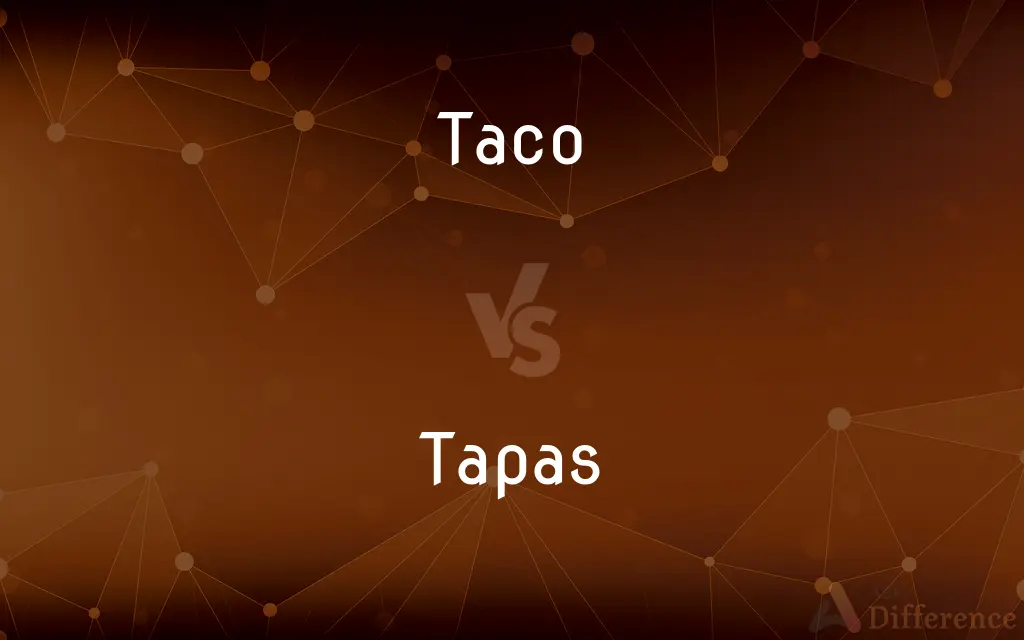Taco vs. Tapas — What's the Difference?
By Tayyaba Rehman & Urooj Arif — Updated on February 29, 2024
Taco is a traditional Mexican dish consisting of a corn or wheat tortilla folded or rolled around a filling, while tapas are a variety of small Spanish appetizers or snacks, served cold or hot, designed to encourage sharing and conversation.

Difference Between Taco and Tapas
Table of Contents
ADVERTISEMENT
Key Differences
Tacos, originating from Mexico, are characterized by their simple yet versatile nature, typically featuring a soft or hard tortilla filled with ingredients like beef, chicken, seafood, vegetables, and cheese. This singular dish focuses on the harmony of its components within the tortilla. Tapas, on the other hand, are not limited to a specific ingredient set but are defined by their serving size and the culture of shared dining in Spain. They can range from olives and cheese to complex hot dishes, embodying the Spanish ethos of communal eating and variety.
The preparation of tacos involves stuffing a tortilla with various fillings and often garnishing with salsa, cilantro, onions, and lime. This method highlights the individual flavors and textures of each component, aiming for a balanced and complete dish in every bite. Tapas encompass a broader culinary technique, from simple assembly of ingredients like cheeses and cured meats to intricate cooking methods for dishes such as gambas al ajillo (garlic shrimp) or patatas bravas (spicy potatoes), showcasing a wide range of Spanish cooking techniques.
Taco fillings are typically seasoned with traditional Mexican spices, such as cumin, chili powder, and paprika, creating a distinctive flavor profile that is both bold and satisfying. The essence of a taco is its filling, which is expected to stand out as the star of the dish. Tapas, however, might feature a wider array of flavors, from the simple saltiness of marinated olives to the complex layers of a seafood paella tapa, reflecting the diverse culinary regions of Spain.
Tacos are often consumed as a main meal, signifying their role as a staple in the Mexican diet in Mexico. They are served at all times of the day, from breakfast tacos with eggs and chorizo to late-night street tacos filled with al pastor. Tapas, conversely, are traditionally served in bars or taverns in Spain as a small snack to accompany drinks, with the intention of fostering social interactions and extending the time spent in communal settings.
Tacos represent a deep-rooted tradition in Mexican cuisine, often enjoyed in both casual and festive settings. They embody the simplicity and richness of Mexican flavors. Tapas, embodying the Spanish tradition of leisure and conversation, are more than just food; they are a cultural activity meant to encourage dialogue and interaction among diners, making them a fundamental part of social life in Spain.
ADVERTISEMENT
Comparison Chart
Origin
Mexico
Spain
Main Ingredients
Corn or wheat tortilla, meats, vegetables, cheese
Varied, including meats, seafood, vegetables, cheese
Serving Size
Individual serving, usually eaten by hand
Small portions, designed for sharing
Preparation
Filled and sometimes garnished with salsa or lime
Can range from simple to complex, served hot or cold
Flavor Profile
Often bold and spicy, featuring traditional spices
Wide range, from simple and savory to complex
Consumption Time
Any time of day, often as a main meal
Typically served as appetizers or snacks with drinks
Cultural Significance
Symbol of Mexican cuisine, enjoyed in various settings
Part of social life, encouraging conversation and sharing
Compare with Definitions
Taco
A Mexican dish of a folded or rolled tortilla filled with various ingredients.
I had a delicious taco filled with grilled chicken and avocado salsa for lunch.
Tapas
Tapas can range from simple dishes like almonds or cheese to more elaborate preparations.
The tapas bar served an incredible patatas bravas with a spicy tomato sauce.
Taco
Tacos can be served with a variety of fillings, including meats, vegetables, and cheese.
For dinner, we made vegetarian tacos with black beans and roasted peppers.
Tapas
Small Spanish appetizers or snacks, served either cold or hot, often shared among diners.
We ordered a selection of tapas, including olives, cheese, and calamari, to start our meal.
Taco
Can come in soft or hard shells, catering to different texture preferences.
She prefers soft shell tacos for their tender bite and flavor.
Tapas
Designed to encourage communal dining and conversation over food.
Sharing tapas at the table led to great conversations and a more interactive dining experience.
Taco
A versatile dish that can be adapted to suit various dietary needs and preferences.
They offered gluten-free tacos at the party, which was a thoughtful touch.
Tapas
Often accompanied by drinks, tapas are a staple in Spanish bars and restaurants.
Along with our wine, we enjoyed a variety of tapas that perfectly complemented the flavors.
Taco
Often garnished with fresh cilantro, onions, and a squeeze of lime to enhance flavor.
He added lime and cilantro to his taco for an extra burst of freshness.
Tapas
Reflects the diverse culinary traditions of Spain, offering a wide array of flavors and ingredients.
The tapas menu showcased dishes from various regions of Spain, providing a culinary tour.
Taco
A taco (US: , UK: , Spanish: [ˈtako]) is a traditional Mexican dish consisting of a small hand-sized corn or wheat tortilla topped with a filling. The tortilla is then folded around the filling and eaten by hand.
Tapas
A tapa (Spanish pronunciation: [ˈtapa]) is an appetizer or snack in Spanish cuisine. Tapas may be cold (such as mixed olives and cheese) or hot (such as chopitos, which are battered, fried baby squid, or patatas bravas).
Taco
A corn tortilla folded around a filling such as ground meat or cheese.
Tapas
A variety of Spanish small savoury food items or snacks such as croquettes, cured meat, potato salad, and seafood, originally served with sherry and now often with other alcoholic beverages as well.
The Spanish restaurant’s tapas is so tasty.
Tapas are so tasty.
Taco
(culinary) A Mexican snack food made of a small tortilla (soft or hard shelled) filled with ingredients such as meat, rice, beans, cheese, diced vegetables and salsa.
Common Curiosities
What is the main difference between tacos and tapas?
Tacos are a specific Mexican dish consisting of tortillas filled with various ingredients, while tapas are a variety of small Spanish dishes designed for sharing.
Can tacos be considered a type of tapas?
No, tacos are not traditionally considered tapas, as they originate from Mexico and are a distinct dish rather than a style of serving.
Are tapas always served hot?
No, tapas can be served either hot or cold, depending on the dish.
What are common fillings for tacos?
Common fillings include beef, chicken, seafood, beans, and vegetables, often seasoned with Mexican spices.
Is it common to eat tacos as a main meal?
Yes, tacos are often eaten as a main meal in Mexico and can be adapted for any meal of the day.
Do tapas always have to be Spanish dishes?
Traditionally, tapas are Spanish, but the concept of small, shareable plates has been adopted globally with variations in ingredients and cuisines.
Can tapas be a full meal?
While traditionally served as snacks, a variety of tapas can be combined to make a full and satisfying meal.
Do tapas require utensils to eat?
Some tapas can be eaten with fingers, while others may require utensils, depending on the dish's complexity.
Are tacos and tapas suitable for a quick snack?
Tacos can be a quick meal option, whereas tapas are perfect as small snacks, especially in a social setting.
Can vegetarians enjoy tacos and tapas?
Yes, both tacos and tapas can be prepared with vegetarian ingredients, offering plenty of options for vegetarians.
Are tacos typically spicy?
Tacos can be spicy depending on the fillings and sauces used, but they can also be mild to cater to different tastes.
What is the cultural significance of tapas in Spain?
Tapas are a fundamental part of social life in Spain, emphasizing communal dining, conversation, and leisure.
How do tacos reflect Mexican culture?
Tacos embody the richness and diversity of Mexican cuisine, celebrated for their flavors and versatility in various settings.
How do the flavors of tacos and tapas compare?
Tacos often feature bold and spicy flavors typical of Mexican cuisine, while tapas offer a wide range of tastes from simple to complex, reflecting Spain's diverse culinary traditions.
Is there a specific time of day to eat tapas?
Tapas can be enjoyed at any time but are commonly served in the late afternoon or early evening as a prelude to dinner in Spain.
Share Your Discovery

Previous Comparison
Somewhere vs. Elsewhere
Next Comparison
Lemma vs. LexemeAuthor Spotlight
Written by
Tayyaba RehmanTayyaba Rehman is a distinguished writer, currently serving as a primary contributor to askdifference.com. As a researcher in semantics and etymology, Tayyaba's passion for the complexity of languages and their distinctions has found a perfect home on the platform. Tayyaba delves into the intricacies of language, distinguishing between commonly confused words and phrases, thereby providing clarity for readers worldwide.
Co-written by
Urooj ArifUrooj is a skilled content writer at Ask Difference, known for her exceptional ability to simplify complex topics into engaging and informative content. With a passion for research and a flair for clear, concise writing, she consistently delivers articles that resonate with our diverse audience.
















































